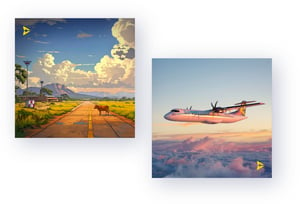How to use the Scandlearn logo
Discover the essential guidelines for using the Scandlearn brand mark with accuracy and consistency in all courseware and communications. Following these standards ensures our brand is represented clearly and professionally every time.
13-10-25
 |
Christopher D'Esposito, Graphic Designer |
Our logotype and mark are the most recognisable elements of the Scandlearn brand, which means that a consistent implementation is crucial for immediate identification.
Our logo is more than just a branded asset on our courseware, website or any other communication: it's a visual representation of our brand that includes everything from our values and mission to our personality. Understanding how our logo works and how it supports our identity will make you a better brand representative.

Logo design
Our brand mark is made up of our logotype in small caps with a confident weight, it is accompanied by the Scandlearn logomark, an arrowhead design that represents our tireless goal of moving ourselves and the industry forward; providing a bold vision of what is possible in aviation learning.
This means that our brand reflects a modern take on e-learning with courses that are not only always up-to-date, but presented using the latest technology and methods for more engaging and effective learning.
The Scandlearn logotype and logomark should only be reproduced using the assets provided in the Core Elements Kit. They must never be modified or altered in any way. Both logo elements should be applied with consideration and attention to detail.
Core Elements Kit
Logo types & variations
Our logo has variations that will work for most contexts and environments. They should all be applied in a similar fashion no matter the situation.
Primary logo
The primary logo is a landscape design that includes the logotype and mark in a lock-up. It is the foundation of our whole brand. There is no vertical variation.

The secondary logo next to an example of how it can be used to represent our logo in a condensed manner.
Secondary logo
A minimised version of our logo exists that features only the arrowhead logo mark. This flexible element can be used to represent our logo in confined spaces, to anchor a page layout, or in isolation as a graphic asset.
Colour variations
The logo can be used in one of two colour variations, either in our yellow #FDDC00, the preferred variation. For layouts that have a light background an inversed version using blue #1F285B can also be used. The same system applies when utilising the secondary logo.
Logo size
To help ensure that our logo always looks clear, and that its size and scale are proportionate to its context, some guidelines should be followed.
The primary and secondary minimised versions of the logo both have a minimum height that helps to ensure that they both remain legible on screens.
For artwork with limited space, use the secondary logo and apply it at the maximum possible size, ensuring the logo’s safe area is maintained.
Safe area
The safe area defines the minimum clear space that must surround our brand mark to ensure it remains legible, recognisable, and free from visual clutter. This space protects the logo from being crowded by other design elements such as text, images, or borders, maintaining its visual integrity and impact across all applications.
The safe area is calculated using the height of the logo itself, where X=h. This unit is applied evenly around the entire logo (both the primary and secondary versions) to create a consistent margin. No other graphic elements or text should enter this space under any circumstances.
Treatment in communications
The written name of our brand is an extension of the logo itself when used in any communications.
When using Scandlearn in written form, the S should always be capitalised and it should not be changed in any way. This includes using a plural version of the name.
Placement and use
Consistent logo placement helps create a unified and professional brand presence across all digital and communication materials. Whenever possible, the logo should be positioned in one of the corners of the artwork—typically the top left or bottom right—to maintain visual balance and ensure brand recognition without distracting from key content.

In layouts such as documents, presentations, and digital banners, place the logo within its defined safe area, ensuring it is not crowded by text, images, or other design elements.
For information on how to display the secondary minimised logo on our courseware, read the article on [TBI].
Avoid placing the logo at the centre of layouts or over complex backgrounds, as this can reduce legibility and detract from the overall message. Consistent placement ensures the logo remains visible, respected, and seamlessly integrated across all applications.
Logo misuse
To maintain the integrity and consistency of our brand identity, it’s essential that the logo is always used correctly. The following guidelines provide clear examples of inappropriate usage to avoid.
- Do not move the logo type or the logo mark from their lock-up.
- Do not resize elements independently.
- Do not recolour the logo.
- Do not skew or distort the logo.
- Do not add effects to the logo.
- Do not modify the colour relationship of the elements.
- Do not change the font of the logo type.
- Do not add or subtract elements from the logo.
 |
Christopher D'Esposito, Graphic Designer |
